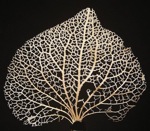friday, july 31, 2009
Not-so-bad articles of Wikipedia
In the spirit of Best of Wikipedia and Wikipedia Time: the best of wiki, these are some of the more interesting articles that I’ve worked on:
 Anastomosis — a network of streams that both branch out and reconnect, such as blood vessels or leaf veins.
Anastomosis — a network of streams that both branch out and reconnect, such as blood vessels or leaf veins.- Black fax — a prank fax transmission consisting of one or more pages filled with a uniform black tone. See also: Lace card.
- Blood wings — an officially banned military initiation rite/hazing ceremony where a badge is pressed into flesh.
- Bucha effect — a disorientation-inducing effect of a strobe light flashing at approximately the frequency of human brainwaves.
 Coprolites — fossilized animal dung, once mined on an industrial scale for use as fertilizer due to its high phosphate content.
Coprolites — fossilized animal dung, once mined on an industrial scale for use as fertilizer due to its high phosphate content.- Drip gas — a naturally occurring form of gasoline, sneakily used in vehicles during the Great Depression with unpredictable results.
- Duplicating machines — the mechanical predecessors of the modern copy machine: mimeograph, ditto machine, hectograph, etc.
- Hibiscus tea — a herbal infusion consumed both hot and cold around the world, also known as roselle, jamaica, karkady, bissap, and sorrel.
- Hypomnema — the ancient Greek equivalent of commonplace books, according to Foucault. See the talk page for a discussion of factual accuracy.
 Shagreen — a type of rawhide made from stingray skin, fashionable during times of excess as a covering on household items.
Shagreen — a type of rawhide made from stingray skin, fashionable during times of excess as a covering on household items.
comments (0)
saturday, july 11, 2009
Learning to see wooden poles
When I’m not in a rush to get somewhere, I look up at the tops of telephone poles. I don’t know anything about electricity, but I find myself reading glossaries of linemen’s slang and technical definitions, learning how to refer to the grey buckets that transform electricity for home use (cans, bugs, distribution transformers) and how to identify several other pole features, especially different varieties of shiny ceramic insulators.
To get from place to place I always walk or look out a car/bus/train window; I don’t know how to drive and don’t feel safe on a bicycle around cars. So I walk a lot, and usually I have something to think about while I’m walking — but if I don’t, and if the sky isn’t too bright, I peer nearsightedly at glossy cylinders tied to wires.
I got interested in utility poles in late 2006 after picking a yellowing antiques magazine off a stack in my grandma’s overstuffed house — it had an article about collecting glass insulators, and I was puzzled. I looked at the pictures but couldn’t figure out what these things were. Their collectors didn’t explain; they talked about cataloging varieties and identifying falsely-tinted specimens.
Later I read more about insulators online, and the fervor of collectors’ websites overwhelmed me a little, but I learned that insulators are devices that sit near the tops of poles to support live wires. Most glass ones have been retired and replaced by ceramic ones, so glass insulators are a beloved collector’s item: produced in a limited quantity, portable, and pretty.
In December I visited my boyfriend’s uncle’s ranch, which grows junk: rusty vehicles, cow bones, fallen streetlights, and, among the weeds, a pile of ceramic insulators. I took photos up close, admiring the glazed bells. I could have asked to grab a set, but where would I keep such a heavy thing? The pile waits there for me to visit again.
I like functional and authentic technical equipment, the more elaborate and less appreciated the better. I get excited about trains and oil wells too, but I don’t see them on my walk to class every day — and they have an amount of built-in spectacle already. Reading about insulators led to noticing a whole ecology of lightning arresters, guy lines, strain insulators, and more.
Some of my friends and I have similar childhood memories: we read Richard Scarry books, where friendly drawings with animal-people explain how an entire town functions, from the paper mill to how the roads are laid; we watched the segment of Mister Rogers’ Neighborhood that explained a crayon factory; and we built flocks of LEGO houses and cars.
Those friends are now computer programmers, while I didn’t understand math past the first semester of Algebra II and never took a physics class. I don’t understand electricity at all, but you don’t have to be a zoology student to spot birds. (My friend working on a master’s degree in bird research makes time to practice medieval-style archery.) I’ve stopped for minutes to stare at a lineman up in a bucket, grasping a line with a pole.
One time I considered waiting until the linemen came down and then politely asking them about what they were fixing, maybe even asking where I could find old broken insulators. But I didn’t think they’d welcome my strange questions, and I knew I had to start walking again — quickly, so I wouldn’t be late for class.
Update: There’s some discussion at Snarkmarket.